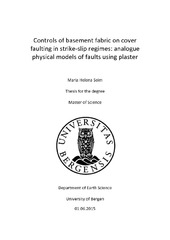| dc.description.abstract | The full complexity of deformation associated with natural faults is difficult to understand, given the lack of three-dimensional exposure in outcrop and the limitations of seismic resolution in the sub-surface. Analogue physical experiments are therefore widely used to gain insight into the nature and evolution of deformation associated with fault growth. In this study we use plaster of Paris to gain insight into fault evolution in strike-slip regimes; specifically, we investigate the effect of different basement structural templates on the evolution of faults in the cover (plaster). The small-scale structures developed in plaster experiments can quite accurately mimic natural fault systems. The grain size and rheology of plaster of Paris makes the development and preservation of detailed structural geometries possible. Basement templates with differently angled restraining and releasing bends were made, for studying structures formed by transpressive and transtensive deformation, respectively. A cover sequence of plaster mixture was poured into a sealed box; manual movement (pulling by hand) controlled the amount of strain and deformation in the ensuing experiments. Based on the finished models, results show how the positive flower structure geometry is affected by the restraining bend angle. Specifically, the pop-up structures comprise more fault blocks in models with lower-angled restraining bends, and the fault blocks form at a later stage in the deformational process in experiments with higher-angled bends. The geometry of the fault blocks changes according to the bend angle. The results also give insight into pull-apart basin development; they indicate that the aspect ratio of the pull-apart basins increases when increasing the angle of the releasing bends. Analogue plaster modelling can, as seen herein, provide valuable insight into fault evolution and associated minor deformation. | en_US |
